I find myself clearing up food safety myths quite often on my social media pages, and to be honest, I probably wouldn’t know about a lot of these if it weren’t for my years of experience in the food industry.
Food safety often gets overlooked when cooking at home, but knowing the facts could save you from an unpleasant bout of food poisoning. Below, I’m outlining 8 of the most common food safety myths that could make a big difference in keeping you healthy:
Myth 1: Dates on food are expiration dates.
In the U.S., open dating, which is a calendar date applied to a food product by the manufacturer or retailer, is found on most foods, including meat, poultry, egg and dairy products. These dates provide consumers with information on the estimated period of time for which the product will be of best quality and to help the store determine how long to display the product for sale. Product dating is not required by federal regulations, except for infant formula. These dates are not an indicator of the product’s safety (except for infant formula), rather, they help consumers and retailers decide when food is of best quality.
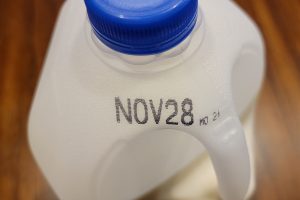
There are no uniform or universally accepted open dating descriptions on food labels in the U.S. Here are some examples of commonly used phrases:
- “Best if Used By/Before” dates indicate when a product will be of best flavor or quality. It is not a purchase or safety or expiration date.
- “Sell-By” dates tell the store how long to display the product for sale for inventory management. It is not a safety or expiration date.
- “Use-By” dates are the last date recommended for the use of the product while at peak quality. It is not a safety or expiration date, except for when used on infant formula.
- “Freeze-By” dates indicate when a product should be frozen to maintain peak quality. It is not a purchase, expiration, or safety date.
If handled properly, many food products can be consumed safely past these dates until the time spoilage is evident.
Myth 2: Raw milk is just as safe as pasteurized and is more nutritious.
Despite pasteurization being one of public health’s most effective food safety interventions ever, the raw milk myths persist. The benefits of heating or boiling milk have been recognized since the early 1800s and have been used to reduce milk-borne illness and mortality in infants since the late 1800s.
Raw milk can carry dangerous germs, such as brucella, campylobacter, cryptosporidium, E. coli, listeria, and salmonella. Foodborne illnesses such as typhoid, scarlet fever and tuberculosis were virtually eliminated with the commercial implementation of pasteurization. According to the Centers for Disease Control and Prevention, “The risk of outbreaks linked to raw milk is at least 150 times greater than the risk of outbreaks linked to pasteurized milk.”
Not only is it safer, but pasteurized milk provides the same nutritional benefits as raw milk, which I covered in more detail in this piece titled, Risks and benefits associated with raw milk.
Myth 3: Homemade mayo is just as safe as store bought.
This myth comes from a TikTok video that I covered recently. Similar to raw cookie dough, homemade mayo made with raw eggs can be unsafe. Salmonella can get on the shells of eggs when birds lay eggs or when the eggs touch bird droppings after being laid. Salmonella also can contaminate the egg’s contents while it is forming inside the chicken before shells are formed.
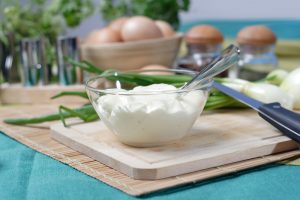
Commercial mayo products on store shelves are made with pasteurized eggs, so it’s safer than making it at home with non-pasteurized raw eggs. However, there is a way to make safe homemade mayo. According to the U.S. Department of Agriculture, “Homemade mayonnaise can be safely made if raw, in-shell pasteurized eggs or pasteurized egg products are used.”
Myth 4: Raw cookie dough is unsafe because of the raw eggs.
Ok, this one is partially true. Raw cookie dough is unsafe due to raw eggs that could be contaminated with salmonella, but what many people don’t know is that it’s also unsafe due to the raw flour.
Typically we don’t think of flour as being “raw,” but what this means is that it hasn’t been heat treated to kill bacteria that may cause food poisoning, such as Escherichia coli (E. coli). Baking is what kills these bacteria and makes it safe to eat. Alternatively, there are food safe raw cookie dough products that are made with heat treated flour and pasteurized eggs or without eggs.
Myth 5: Washing or rinsing poultry in the sink gets rid of harmful bacteria
Washing or rinsing meat or poultry can cause the bacteria present in raw meat and poultry juices to be spread to other foods, utensils and surfaces.
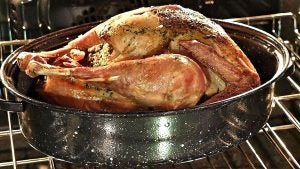
Recent USDA research found that washing or rinsing meat or poultry increases the risk for cross-contamination in the kitchen, which can cause foodborne illness. Cooking meat and poultry to the proper temperature kills bacteria, so washing these products is risky and not necessary.
Myth 6: You need to soak fruits and vegetables in a produce wash before consuming.
Washing fruits and vegetables with soap, detergent, or commercial produce wash is not recommended. The safety of the residues of commercial produce washes is not known and their effectiveness has not been tested. Washing produce thoroughly under cool, drinkable water is sufficient.
In addition, washing produce with skin, even if you don’t plan to eat the skin, is important so that dirt and bacteria are not transferred from the surface when peeling or cutting it.
Read through these safe handling tips for more information on how to reduce foodborne illness risk when it comes to fresh produce.
Myth 7: Moldy food is safe to eat as long as you cut out the moldy parts.
This is another one that is partially true, but it’s not true for all foods. Some molds cause allergic reactions and respiratory problems. In the right conditions, some molds produce “mycotoxins,” which are poisonous substances that can make you sick.
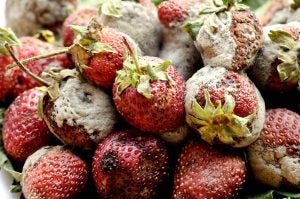
According to USDA’s Food Safety Inspection Service, there are some foods, such as hard cheeses and firm vegetables that are ok to consume after cutting off at least 1 inch around and below the mold spot. These are foods where mold generally cannot penetrate deep into the product. There are many other foods that should be discarded if they contain molds that are not a part of the manufacturing process. These foods are generally high in moisture content and can be contaminated below the surface, for example cooked pasta, soft cheeses, jams, jellies and soft fruits and vegetables.
Myth 8: You should rinse pre-packaged salad greens.
Leafy green salads in sealed bags labeled “pre-washed” or “ready-to-eat” do not require additional washing unless directed on the label. Additional washing at time of use isn’t likely to increase safety, and in fact, washing could increase risk of cross-contamination if it comes into contact with unclean surfaces or utensils.
In addition to all of this, always make sure to practice these safe food handling practices at home: Wash hands and surfaces often, separate raw meats from other foods, cook to the right temperature, and refrigerate foods promptly.
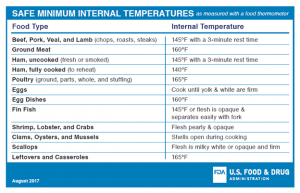
Food Science Babe is the pseudonym of an agvocate and writer who focuses specifically on the science behind our food. She has a degree in chemical engineering and has worked in the food industry for more than decade, both in the conventional and in the natural/organic sectors.



